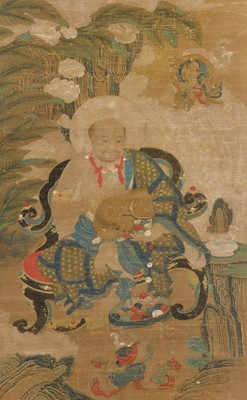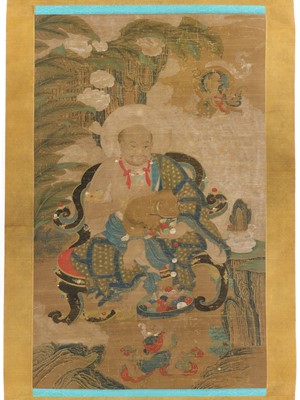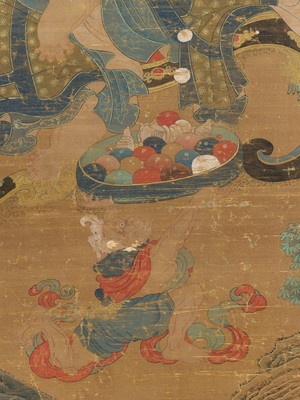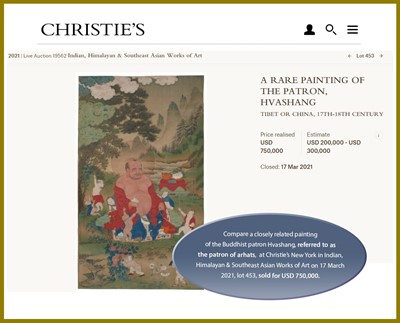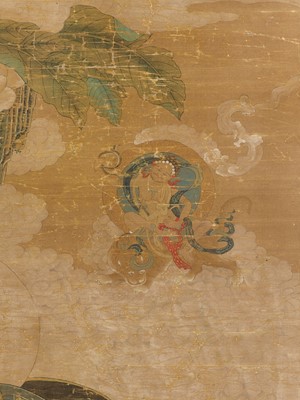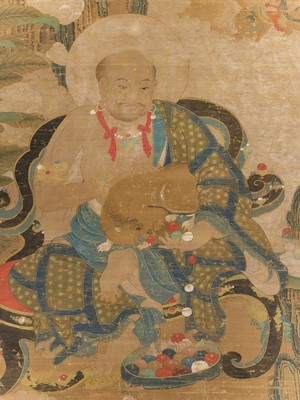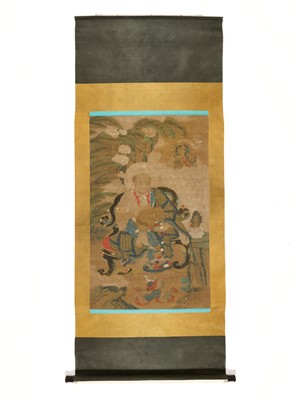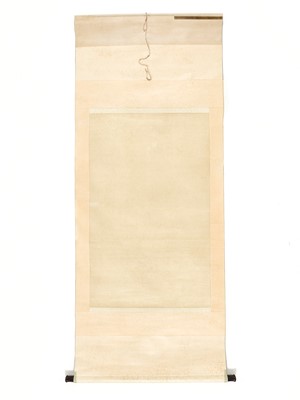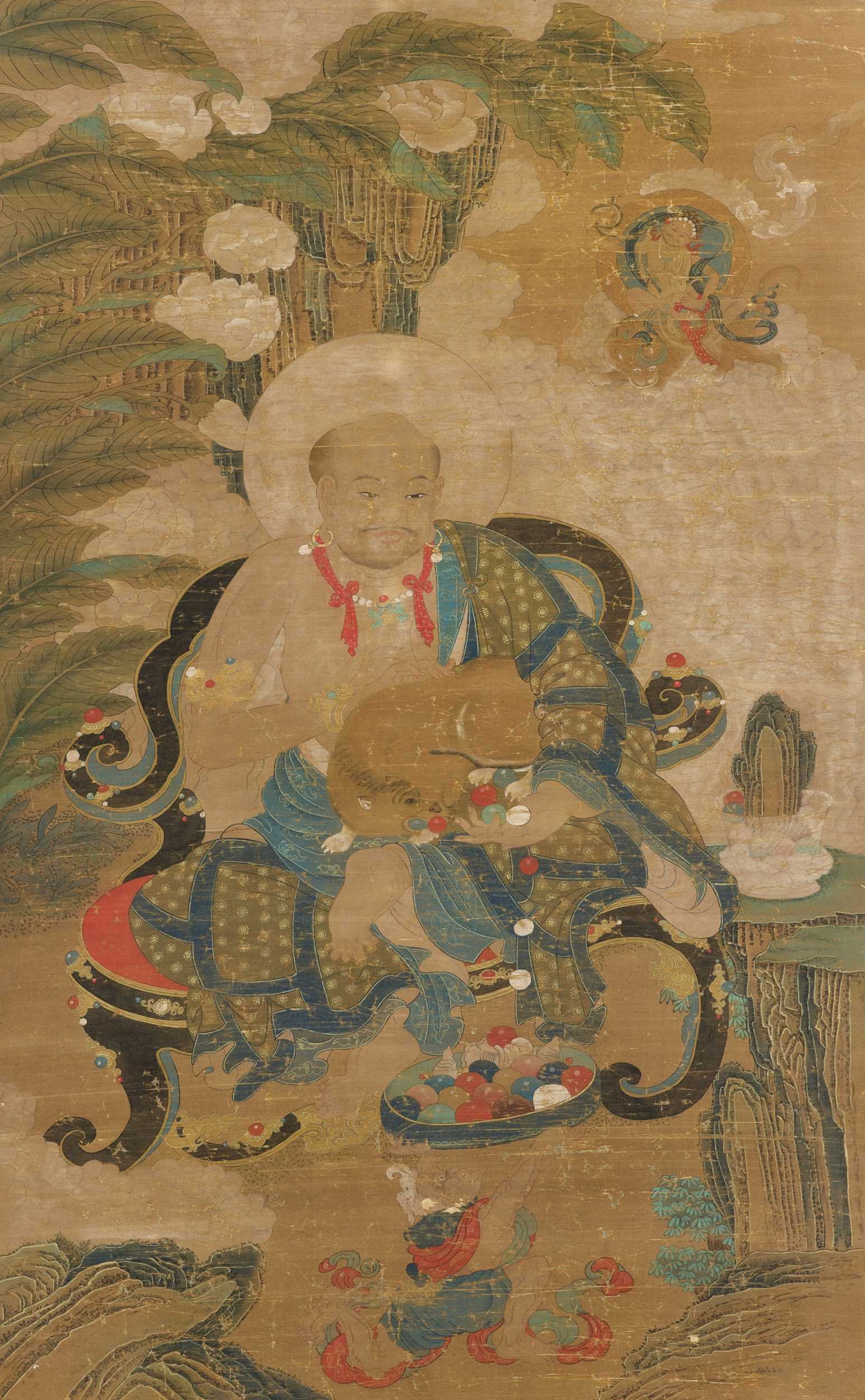11th Mar, 2022 10:00
DAY 2 - TWO-DAY AUCTION - Fine Chinese Art / 中國藝術集珍 / Buddhism & Hinduism
535
A RARE AND IMPORTANT PAINTING OF THE ARHAT BAKULA, 17TH-18TH CENTURY
十七至十八世紀重要囉怙羅尊者像
Sold for €27,808
including Buyer's Premium
China. Ink and watercolors on silk. The Meditating Luohan seated on a fine and richly bejeweled throne, a halo behind his head, surrounded by clouds, leaves, and craggy rockwork. A mongoose in his arms spews wish-fulfilling jewels which drop into a vessel containing conch shells, held up by a demonic figure, below a transparent lotus cup with further jewels and a rock. Descending from above is Maitreya riding a tiger.
Provenance: UK market, by repute from an old English estate.
Condition: Fair condition with old wear, soilling, creasing, few tears, small losses and minor touchups. With a silk brocade frame and mounted as a hanging scroll.
Dimensions: Image size 110.5 x 68.2 cm, Size incl. mounting 211 x 85.7 cm
Bakula, known as Jinguzo Luohan (Meditating Luohan) in Chinese, is the fifth arhat and often depicted with a mongoose spewing wish-fulfilling jewels, which is also commonly held by Jambhala, the Buddhist God of Fortune and Wealth.
The arhat paintings of the early Ming dynasty owe much to the secular tradition of landscape literati painting in China, and break from the earlier Tibetan compositional practice of Buddhist paintings, in which deities and other important figures are set within a regimented and prescribed hierarchy. In most of the arhat painting sets, the main figures are set within lush landscapes, surrounded by craggy mountains, curving pine boughs, and flowing streams. In the tradition of Chinese literati paintings, nature and country life were seen as an escape from the intrigues of the court, a place where scholars could find the peace needed to write poetry, perform music, and develop ideas. It is no coincidence that the arhats of these early painting sets, figures who represented wisdom and enlightenment, were placed within the tranquil confines of a natural landscape.
The Qing dynasty witnessed a revitalization of the cultural contacts between Tibet and imperial China, and the Manchu ruling class officially patronized Tibetan-style Buddhism in the capital of Beijing. This period also witnessed an explosion in the production of Buddhist art, particularly during the reign of the Qianlong Emperor (r. 1735-1796), thanks to innovations such as the printing press (for producing thangkas) and industrial molds (for producing sculptures). Stylistically, painting sets of the Sixteen Great Arhats from the seventeenth and eighteenth centuries continued to follow the early Ming style, with arhats set in Chinese-style landscapes.
Auction result comparison: Compare a closely related painting of the Buddhist patron Hvashang, referred to as the patron of arhats, also dated 17th-18th century, attributed to “Tibet or China”, at Christie’s New York in Indian, Himalayan & Southeast Asian Works of Art on 17 March 2021, lot 453, sold for USD 750,000.
十七至十八世紀重要囉怙羅尊者像
中國。立軸,絹本水墨設色。尊者盤腿坐在一個鑲滿寶石的華麗寶座上,身後有一圈光背,周圍圍繞著雲彩、樹葉和崎嶇的岩石。 一隻貓鼬臥在他的懷裡,不停地吐出如意寶珠,落入尊者的左手,然後落入一個放置在地上的盤中,與一些佛教之寶海螺一起。一個惡魔人物舉著這個盤子。尊者左側有一岩石,上面有一個透明的蓮花杯,裡面也盛著很多珠寶和一塊山岩。空中的雲彩中可見騎虎彌勒佛。
來源:英國古玩市場,據説來自英國私人老收藏。
品相:狀況良好,有舊時磨損、水漬、摺痕、小缺損和輕微修飾。絲織錦框。
尺寸:畫面110.5 x 68.2厘米,總211 x 85.7厘米
拍賣結果比較:比較一件相近的西藏或中國的十七世紀摩訶衍像,見紐約佳士得 Indian, Himalayan & Southeast Asian Works of Art 2021年3月17日 lot 453, 售價USD 750,000。
China. Ink and watercolors on silk. The Meditating Luohan seated on a fine and richly bejeweled throne, a halo behind his head, surrounded by clouds, leaves, and craggy rockwork. A mongoose in his arms spews wish-fulfilling jewels which drop into a vessel containing conch shells, held up by a demonic figure, below a transparent lotus cup with further jewels and a rock. Descending from above is Maitreya riding a tiger.
Provenance: UK market, by repute from an old English estate.
Condition: Fair condition with old wear, soilling, creasing, few tears, small losses and minor touchups. With a silk brocade frame and mounted as a hanging scroll.
Dimensions: Image size 110.5 x 68.2 cm, Size incl. mounting 211 x 85.7 cm
Bakula, known as Jinguzo Luohan (Meditating Luohan) in Chinese, is the fifth arhat and often depicted with a mongoose spewing wish-fulfilling jewels, which is also commonly held by Jambhala, the Buddhist God of Fortune and Wealth.
The arhat paintings of the early Ming dynasty owe much to the secular tradition of landscape literati painting in China, and break from the earlier Tibetan compositional practice of Buddhist paintings, in which deities and other important figures are set within a regimented and prescribed hierarchy. In most of the arhat painting sets, the main figures are set within lush landscapes, surrounded by craggy mountains, curving pine boughs, and flowing streams. In the tradition of Chinese literati paintings, nature and country life were seen as an escape from the intrigues of the court, a place where scholars could find the peace needed to write poetry, perform music, and develop ideas. It is no coincidence that the arhats of these early painting sets, figures who represented wisdom and enlightenment, were placed within the tranquil confines of a natural landscape.
The Qing dynasty witnessed a revitalization of the cultural contacts between Tibet and imperial China, and the Manchu ruling class officially patronized Tibetan-style Buddhism in the capital of Beijing. This period also witnessed an explosion in the production of Buddhist art, particularly during the reign of the Qianlong Emperor (r. 1735-1796), thanks to innovations such as the printing press (for producing thangkas) and industrial molds (for producing sculptures). Stylistically, painting sets of the Sixteen Great Arhats from the seventeenth and eighteenth centuries continued to follow the early Ming style, with arhats set in Chinese-style landscapes.
Auction result comparison: Compare a closely related painting of the Buddhist patron Hvashang, referred to as the patron of arhats, also dated 17th-18th century, attributed to “Tibet or China”, at Christie’s New York in Indian, Himalayan & Southeast Asian Works of Art on 17 March 2021, lot 453, sold for USD 750,000.
十七至十八世紀重要囉怙羅尊者像
中國。立軸,絹本水墨設色。尊者盤腿坐在一個鑲滿寶石的華麗寶座上,身後有一圈光背,周圍圍繞著雲彩、樹葉和崎嶇的岩石。 一隻貓鼬臥在他的懷裡,不停地吐出如意寶珠,落入尊者的左手,然後落入一個放置在地上的盤中,與一些佛教之寶海螺一起。一個惡魔人物舉著這個盤子。尊者左側有一岩石,上面有一個透明的蓮花杯,裡面也盛著很多珠寶和一塊山岩。空中的雲彩中可見騎虎彌勒佛。
來源:英國古玩市場,據説來自英國私人老收藏。
品相:狀況良好,有舊時磨損、水漬、摺痕、小缺損和輕微修飾。絲織錦框。
尺寸:畫面110.5 x 68.2厘米,總211 x 85.7厘米
拍賣結果比較:比較一件相近的西藏或中國的十七世紀摩訶衍像,見紐約佳士得 Indian, Himalayan & Southeast Asian Works of Art 2021年3月17日 lot 453, 售價USD 750,000。
Zacke Live Online Bidding
Our online bidding platform makes it easier than ever to bid in our auctions! When you bid through our website, you can take advantage of our premium buyer's terms without incurring any additional online bidding surcharges.
To bid live online, you'll need to create an online account. Once your account is created and your identity is verified, you can register to bid in an auction up to 12 hours before the auction begins.
Intended Spend and Bid Limits
When you register to bid in an online auction, you will need to share your intended maximum spending budget for the auction. We will then review your intended spend and set a bid limit for you. Once you have pre-registered for a live online auction, you can see your intended spend and bid limit by going to 'Account Settings' and clicking on 'Live Bidding Registrations'.
Your bid limit will be the maximum amount you can bid during the auction. Your bid limit is for the hammer price and is not affected by the buyer’s premium and VAT. For example, if you have a bid limit of €1,000 and place two winning bids for €300 and €200, then you will only be able to bid €500 for the rest of the auction. If you try to place a bid that is higher than €500, you will not be able to do so.
Online Absentee and Telephone Bids
You can now leave absentee and telephone bids on our website!
Absentee Bidding
Once you've created an account and your identity is verified, you can leave your absentee bid directly on the lot page. We will contact you when your bids have been confirmed.
Telephone Bidding
Once you've created an account and your identity is verified, you can leave telephone bids online. We will contact you when your bids have been confirmed.
Classic Absentee and Telephone Bidding Form
You can still submit absentee and telephone bids by email or fax if you prefer. Simply fill out the Absentee Bidding/Telephone bidding form and return it to us by email at office@zacke.at or by fax at +43 (1) 532 04 52 20. You can download the PDF from our Upcoming Auctions page.
How-To Guides
How to Create Your Personal Zacke Account
How to Register to Bid on Zacke Live
How to Leave Absentee Bids Online
How to Leave Telephone Bids Online
中文版本的操作指南
创建新账号
注册Zacke Live在线直播竞拍(免平台费)
缺席投标和电话投标
Third-Party Bidding
We partner with best-in-class third-party partners to make it easy for you to bid online in the channel of your choice. Please note that if you bid with one of our third-party online partners, then there will be a live bidding surcharge on top of your final purchase price. You can find all of our fees here. Here's a full list of our third-party partners:
- 51 Bid Live
- EpaiLive
- ArtFoxLive
- Invaluable
- LiveAuctioneers
- the-saleroom
- lot-tissimo
- Drouot
Please note that we place different auctions on different platforms. For example, in general, we only place Chinese art auctions on 51 Bid Live.
Bidding in Person
You must register to bid in person and will be assigned a paddle at the auction. Please contact us at office@zacke.at or +43 (1) 532 04 52 for the latest local health and safety guidelines.
